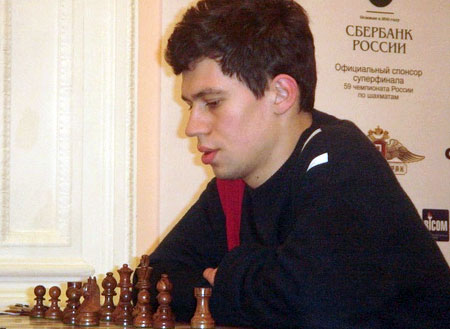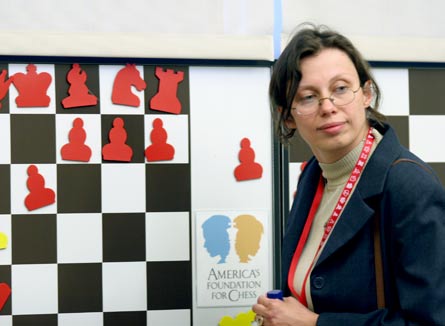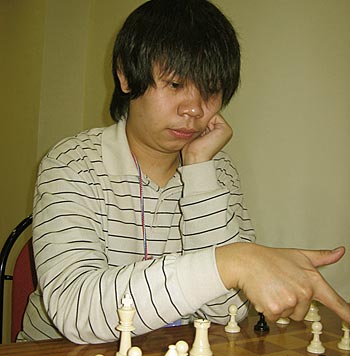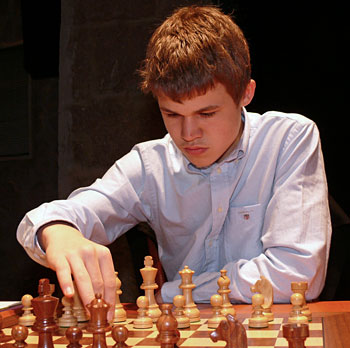| Latest | Greatest | Lobby | Journals | Search | Options | Help | Login |
|
|
|
This topic is archived. |
| Home » Discuss » Topic Forums » Sports |
|
| Jack Rabbit
|
Sun Feb-25-07 10:16 PM Original message |
| The Jack Rabbit Chess Report for February 25 |
|
Edited on Sun Feb-25-07 10:42 PM by Jack Rabbit
The Jack Rabbit Chess Report for the week ending February 25  Contents Post 1: News for the week Post 2: Diagrams and other features Post 3: Games from Current and Recent Events |
| Printer Friendly | Permalink | | Top |
| Jack Rabbit
|
Sun Feb-25-07 10:17 PM Response to Original message |
| 1. News for the week ending February 25 |
|
Edited on Sun Feb-25-07 10:19 PM by Jack Rabbit
Alekseev wins Aeroflot Open
 Reigning Russian national champion Evgeny Alekseev won the 6th annual Aeroflot Open Thursday by defeating Armenian grandmaster Gabriel Sargissian in the final round in Moscow. Alekseev enter the final round tied for first place with two other Russians, Dmitry Jakovenko and Evgeny Tomashevsky, with 6 points each. The Swiss system pairing pitted Tomashevsky and Jakovenko against each other in a game that ended in a darw after only 14 moves. Sargissian started the final round tied for fourth with 5½ points. Alekseev, playing White against Sargissian, showed little ambition in the opening, playing a neo-classical Italian Game commonly called the Guicco Pianissmo, which is Italian for "very quiet game". It is regarded as a tacit invitation to a quiet draw. However, Sargissian had his own chance of finishing tied for first and played for complications, forcing Alekseev to play more agressively. Alekseev got the upper hand late in the game. Sargissian resigned on his 41st move with a snowballing material deficit. For winning the Aeroflot, Alekseev is invited to participate in this summer's elite Sparkassen Chess Meeting in Dortmund. Magnus, Anand lead Morelia-Linares as the scene shifts to Spain  Sixteen-year-old Norwegian grandmaster Magnus Carlsen and veteran Indian grandmaster Vishy Anand are tied for the lead in the Morelia-Linares Super GM Tournament the half-way point with 4½ points each in seven rounds as the players concludes the first leg of the double-round robin event in Morelia, Michoacán (Mexico). Both players have won 3, lost 1 and drawn 3. Magnus' victories are his first in elite grandmaster competition. He competed in the Tal Memorial Tournament in November and Group A of the Corus Tournament last month, both category 19 events, without winning a game in either. Anand won the individual game between them. The oldest player in the tournament, grandmaster Vassily Ivanchuk of Ukraine, is in third place with four points. Unofficial Cross Table Super GM Tournament Morelia-Linares ------------------------- 1- 2- 3- 4- 5- 6- 7- 8- T- (W) 1 Vishy Anand. . . . . . .-- 1* ½* 0* ½* ½* 1* 1* 4½ (3) 2 Magnus Carlsen . . . . .0* -- 1* ½* ½* 1* ½* 1* 4½ (3) 3 Vassily Ivanchuk . . . .½* 0* -- 1* ½* 1* ½* ½* 4. (3) 4 Levon Aronian. . . . . .1* ½* 0* -- ½* ½* ½* ½* 3½ (1) 5 Peter Svidler. . . . . .½* ½* ½* ½* -- ½* ½* ½* 3½ (0) 6 Veselin Topalov. . . . .½* 0* 0* ½* ½* -- ½* 1* 3. (1) 7 Peter Leko . . . . . . .0* ½* ½* ½* ½* ½* -- ½* 3. (0) 8 Alexander Morozevich . .0* 0* ½* ½* ½* 0* ½* -- 2. (0) The Jack Rabbit Unofficial Cross Table uses games won as first tie break The tournament now adjourns and reconvenes Friday in the Andalusian town of Linares, which was the exclusive tournament site until last year, The official website for the Linares leg of the tournament is Soloajerez.com. |
| Printer Friendly | Permalink | | Top |
| Jack Rabbit
|
Sun Feb-25-07 10:20 PM Response to Original message |
| 2. Diagrams and other features of the JR Chess Report |
|
!""""""""# $tMvWlVmT% $OoOoOoOo% $ + + + +% $+ + + + % $ + + + +% $+ + + + % $pPpPpPpP% $RnBqKbNr% /(((((((() White to move This position is a theoretical draw Does this picture make sense to you? If not, or if it looks like a bunch of Wingdings, please click here. Diagrams used in the Jack Rabbit Chess Report are made with Chess Merida, a true type font that is available as freeware at the above link. Also, the JR chess report makes the main variation in annotations more distinct and readable by putting it in red. A secondary variation, is in blue and other colors are used if needed. |
| Printer Friendly | Permalink | | Top |
| Jack Rabbit
|
Sun Feb-25-07 10:21 PM Response to Original message |
| 3. Games from current and recent events |
|
Edited on Sun Feb-25-07 10:44 PM by Jack Rabbit
Chess Games Analysis by JR and Fritz Evgeny Tomashevsky - Artashes Minasian, Aeroflot Open, Round 7, Moscow Evgeny Alekseev - Gabriel Sargissian, Aeroflot Open, Round 9, Moscow Magnus Carlsen - Vishy Anand, Super GM Tournament, Round 3, Morelia Camilla Baginskaite - Bill Orton, North American FIDE Open, Round 4, Stillwater, Oklahoma Endgame: Parimarjan Negi - Wang Hao, Aeroflot Open, Round 2, Moscow Endgame: Magnus Carlsen - Alexander Morozevich, Super GM Tournament, Round 1, Morelia |
| Printer Friendly | Permalink | | Top |
| Jack Rabbit
|
Sun Feb-25-07 10:23 PM Response to Reply #3 |
| 4. Tomashevsky - Minashian, Aeroflot Open Round 7, Moscow |
 Evgeny Tomashevsky Evgeny Tomashevsky vs. Artashes Minasian Aeroflot Open, Round 7 Moscow, February 2007 West India Game: Tal-Indian Defense (Beefeaters' Variation) 1. Nf3 g6 2. c4 Bg7 3. d4 c5 4. e4 d6 5. Be2 Nc6 6. d5 Nd4 7. Nxd4 cxd4 8. 0-0 Qb6 9. Nd2 Nf6 10. Rb1 a5 11. b3 0-0 12. a3!?
Black: Artashes Minasian !""""""""# $t+v+ Tl+% $+ + O Vo% $ O W +o+% $+ +p+o+ % $ + +p+ +% $+n+qB + % $ + + PpP% $+rR + K % /(((((((() White: Evgeny Tomashevsky Position after 22. -- f7f5 23. f3!?
Black: Artashes Minasian !""""""""# $ + + +l+% $+ + + +o% $vO PoWo+% $+ + + + % $ + Vp+ +% $+qT Bn+p% $ + + +p+% $+r+ + K % /(((((((() White: Evgeny Tomashevsky Position after 32. -- Rc8c3 33. Bxd4!!
|
| Printer Friendly | Permalink | | Top |
| Jack Rabbit
|
Sun Feb-25-07 10:27 PM Response to Reply #3 |
| 5. Alekseev - Sargissian, Aeroflot Open Round 9, Moscow |
 Evgeny Alekseev Evgeny Alekseev vs. Gabriel Sargissian Aeroflot Open, Round 9 Moscow, February 2007 Italian Royal Game: Neo-Classical Defense (Clam Opening) (Giucco Pianissimo) 1. e4 e5 2. Nf3 Nc6 3. Bc4 Bc5 4. c3 Nf6 5. d3
Black: Gabriel Sargissian !""""""""# $ + Tt+l+% $+ O +oO % $oVv+w+mO% $+o+ O + % $p+ +p+p+% $+ P + + % $ Pb+qPp+% $R Br+ K % /(((((((() White: Evgeny Alekseev Position after 22. -- Rd8 23. a5?!
Black: Gabriel Sargissian !""""""""# $ +t+t+l+% $Q O +oO % $o+v+w+ +% $+ + On+m% $ + +p+ +% $+ P +pP % $ PbR + +% $R + + K % /(((((((() White: Evgeny Alekseev Position after 30. -- Nf6h5:p 31. Qe3!
|
| Printer Friendly | Permalink | | Top |
| Jack Rabbit
|
Sun Feb-25-07 10:31 PM Response to Reply #3 |
| 6. Carlsen - Anand, Round 3, Morelia-Linares |
 Vishy Anand Magnus Carlsen vs. Vishy Anand Morelia-Linares Super GM Tournament, Round 3 Morelia, Minoachán (Mexico), February 2007 Semi-Slav Queen's Gambit: Meran Defense 1. d4 d5 2. c4 c6 3. Nc3 Nf6 4. e3 e6 5. Nf3 Nbd7 6. Bd3 dxc4 7. Bxc4 b5 8. Bd3 Bd6
Black: Vishy Anand !""""""""# $ + T + L% $+ + + O % $o+ +o+ +% $+ V +oO % $pO + + +% $+p+ PvP % $ Bb+ P P% $+ R +k+ % /(((((((() White: Magnus Carlsen Position after 26. Kg1f1 26. -- f4!
Black: Vishy Anand !""""""""# $ +r+ + +% $+ + + Ol% $o+ +o+ +% $+ +v+ O % $pO + + +% $+ + BoP % $ T + P P% $+ + + + % /(((((((() White: Magnus Carlsen Position after 39. Bd2e3 39. -- Re2!
|
| Printer Friendly | Permalink | | Top |
| Jack Rabbit
|
Sun Feb-25-07 10:33 PM Response to Reply #3 |
| 7. Baginskaite - Orton, North American FIDE Open, Round 4, Stillwater |
|
Camilla Baginskaite was a member of last year's US women's team in Torino. She was born in Soviet Lithuania and is married to another Soviet expatriot, grandmaster Alex Yermolinsky. They live in San Francisco with their two children.
 Camille Baginskaite To view this game:
Camilla Baginskaite vs. Bill Orton North American FIDE Open, Round 4 Stillwater, Oklahoma, February 2007 Open Queen's Gambit: Alekhine Opening (Queen's Gambit Accepted) 1. d4 d5 2. c4 dxc4 3. Nf3 Nf6 4. e3 Bg4
Black: Bill Orton !""""""""# $ T +l+ T% $+ +m+oO % $o+bV +o+% $+o+ + + % $ + P + +% $P + +k+p% $ P B P +% $R + + +r% /(((((((() White: Camille Baginskaite Position after 23. -- Be7d6 24. Ba5!
|
| Printer Friendly | Permalink | | Top |
| Jack Rabbit
|
Sun Feb-25-07 10:35 PM Response to Reply #3 |
| 8. Endgame: Negi - Wang Hao, Aeroflot Open Round 2, Moscow |
|
This endgame demonstrates the advantage of having an extra pawn.
 Wang Hao Parimarjan Negi vs. Wang Hao Aeroflot Open, Round 2 Moscow, February 2007 Black: Wang Hao !""""""""# $ + + + +% $+ + + + % $t+ + +l+% $Or+ +o+o% $ O + K +% $+p+ + + % $p+ + + +% $+ + + + % /(((((((() White: Parimarjan Negi Position after Black's 38th move 39. Rb8 h4 40. Rg8+ Kh7 41. Rg2 h3
Black: Wang Hao !""""""""# $ + +t+ +% $+ + + + % $ + + + +% $O + + + % $ O + K +% $+p+k+ +o% $p+ + + R% $+ + + + % /(((((((() White: Parimarjan Negi Position after 52. Kf3f4 52. -- Re3
Black: Wang Hao !""""""""# $ +r+ + +% $+ + + + % $ + + + +% $O + + + % $ O L + +% $+p+ + Ko% $p+ + + +% $+ + +t+ % /(((((((() White: Parimarjan Negi Position after 57. Kf4g3 57. -- h2!!
Black: Wang Hao !""""""""# $ + T + +% $+r+ + + % $ + + + +% $+ + + + % $ +l+ + +% $+o+ + + % $ + +k+ +% $+ + + + % /(((((((() White: Parimarjan Negi Position after 67. Ra7b7 67. -- Kc3
Black: Wang Hao !""""""""# $ + + + +% $R + + + % $ + + + +% $+ +t+ + % $ + + + +% $+ + + + % $ O +k+ +% $+l+ + + % /(((((((() White: Parimarjan Negi Position after 72. -- Rd5
|
| Printer Friendly | Permalink | | Top |
| Jack Rabbit
|
Sun Feb-25-07 10:38 PM Response to Reply #3 |
| 9. Endgame: Carlsen - Morozevich, Round 1, Morelia-Linares |
|
Edited on Sun Feb-25-07 10:40 PM by Jack Rabbit
This is an example of the endgame advantage of having pawn majorities on both wings.
 Magnus Carlsen Magnus Carlsen vs. Alexander Morozevich Morelia-Linares Super GM Tournament, Round 1 Morelia, Minoachán (Mexico), February 2007 Black: Alexander Morozevich !""""""""# $ + + + +% $+ + + +o% $ + + Lo+% $O + + + % $ + +b+p+% $+p+ + +p% $p+ V Pk+% $+ + + + % /(((((((() White: Magnus Carlsen Position after Black's 45th move 46. Kg3!
Black: Alexander Morozevich !""""""""# $ + + + +% $+ + + + % $ + + LoO% $O V + + % $ + +b+pP% $+p+k+ + % $p+ + P +% $+ + + + % /(((((((() White: Magnus Carlsen Position after 50. -- Bd6c5 51. f4!
Black: Alexander Morozevich !""""""""# $ + + + +% $+ + + L % $ + + +o+% $P V + Po% $ + +bP P% $+o+k+ + % $o+ + + +% $+ + + + % /(((((((() White: Magnus Carlsen Position after 52. -- Kf6g7 53. Kc4!!
|
| Printer Friendly | Permalink | | Top |
| Jack Rabbit
|
Tue Feb-27-07 06:17 PM Response to Original message |
| 10. Happy birthday to Hou Yifan |
|
The young lady is 13 years old today. In January, Yifan was awarded the title women's grandmaster (WGM) by FIDE. Well earned and many happy returns.
 |
| Printer Friendly | Permalink | | Top |
| DU
AdBot (1000+ posts) |
Wed May 01st 2024, 08:46 AM Response to Original message |
| Advertisements [?] |
| Top |
| Home » Discuss » Topic Forums » Sports |
|
Powered by DCForum+ Version 1.1 Copyright 1997-2002 DCScripts.com
Software has been extensively modified by the DU administrators
Important Notices: By participating on this discussion board, visitors agree to abide by the rules outlined on our Rules page. Messages posted on the Democratic Underground Discussion Forums are the opinions of the individuals who post them, and do not necessarily represent the opinions of Democratic Underground, LLC.
Home | Discussion Forums | Journals | Store | Donate
About DU | Contact Us | Privacy Policy
Got a message for Democratic Underground? Click here to send us a message.
© 2001 - 2011 Democratic Underground, LLC